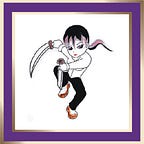Vokhtan Bestiary — food animals
Technically the Tukti should be part of any list of food animals however as they are not common food animals — because they are only eaten by the Vokh and because there is a possibility that they may be sentient — I am not including them in this list.
Akhat
Akhat are small, flightless, bird-like creatures that resemble terran emus with large eyes and long flexible necks. However instead of feathers akaht are covered in soft fur ranging in colour from mid purple to a soft, luminous lavender which allows them to blend in to the grassy plains where they live.
They have two very strong legs with powerful clawed toes that allow them to run very fast and change direction easily. As Akhat are herd animals they rely on safety in numbers and their running ability to get them away from predators.
Akaht are omnivores and their varied diet makes their blood taste salty and a little gamey. They are the favoured food of high ranking iVokh such as healers and seneschals.
The Vokh will feed on akaht as well but only if they are very hungry and tukti are not available, or if their eyries happen to be a long way from the great plains where the akaht herds live.
Most ordinary iVokh will feed off one or more of the following animals, depending on season and availability :
Rock lizards. Rock lizards are six-legged, reptilian scavengers covered in scales which can change colour to match their surroundings. Similar to terran chameleons, they can go from being a drab grey when scurrying around the rocks to a brilliant purple when slinking through the rich vegetation of the ravines.
Rock lizards abound in the ravines and are always plentiful as they breed at a very fast rate. Their blood is nourishing but has a strong smell and a slightly bitter taste.
Ahp. Ahp are fresh water snails which thrive in the small streams of the ravines and canyons. Although they have a shell they cannot retract their bodies completely like the Titi so the iVokh love eating them as snacks, sinking their sharp fangs into the body cavity and then popping the whole ahp into their mouths to suck out the rich, slightly nutty body fluids. When they are done they spit out the flesh.
Like most of the animals of vokhtah Ahp can change the colour of their shells but, as they spend most of their time in water the colour range is usually muddy brown to grey.
Titi. Titi are small barnacle-like crustaceans that spend the daylight hours clinging to rocks just below the waterline of Vokhtan lakes and streams. During the dark however they crawl across damp rocks, feeding on moss, lichen and any dead things they can find.
These scavengers are usually slow moving, creeping across the rocks by pulling themselves along with two tentacle like feet covered in suckers. When threatened they snatch their feet back inside their shells and seal themselves in.
The following short excerpt gives an insight into how the iVokh catch and eat titi when they are out in the wild.
‘By the time the Acolyte reached the shoreline the Second was already belly down on a large, flat rock that jutted out into the lake. The upper half of its body hung down into the water as it scraped at something below the surface. When it sat up a moment later it was brandishing a small slime-encrusted crustacean. Slime covered the Second’s arms as well but it looked quite pleased with itself.
“Watching for predators,” it said as it threw the titi at the young iVokh’s feet. “And keeping titi from crawling away!”
Nodding with a distinct lack of enthusiasm the Acolyte bent towards the slimy creature that was already extending two tentacled feet from within its shell and picked it up between finger and thumb. At the Acolyte’s touch the titi pulled its feet back inside and snapped its shell shut with a sharp snick.
Despite disliking titi intensely the young iVokh found that hunger could make even the most unappealing of food seem appetizing. Wasting no more time lamenting the delicacies it could not have, it stepped carefully over the slippery rocks until it found a nearby boulder that was already starting to steam in the warmth. Quickly building a corral of small stones on top of the boulder it dropped the titi inside and headed back towards the Second who already had another titi ready to be steamed.
Both suns were in the sky when the Second and the Acolyte finally sat down and began pulling the half cooked titi flesh from the shells. The meat was chewy and tough, with an unpleasant after-taste of slime but both iVokh were so hungry they would not have noticed if it had been seasoned with mud.’
Ipti. Ipti are small, fast, rodent-like animals with six legs. It is possible they are distantly related to the tukti because they too are herbivores and have the same general body structure. Like the tukti they have four running legs and two ‘arms’ but unlike the tukti their eyes are small and they have longer snouts with large nostrils. They also lack the tukti whiskers as they do not burrow but instead nest in crevices and caves.
Because Ipti live in caves where the temperature remains fairly constant they lack the downy undercoat of the Tukti and so their bodies look smaller and sleeker — less rounded and fluffy. Another difference is that their fur is a dark grey with only the muzzle and under belly showing any colour — usually a washed out lavender or white.
Ipti teeth are generally larger than those of tukti and this may be because their diet includes the moss, lichen and fungi which must be scraped from the rocks in caves. This cave food makes them taste quite bland.
